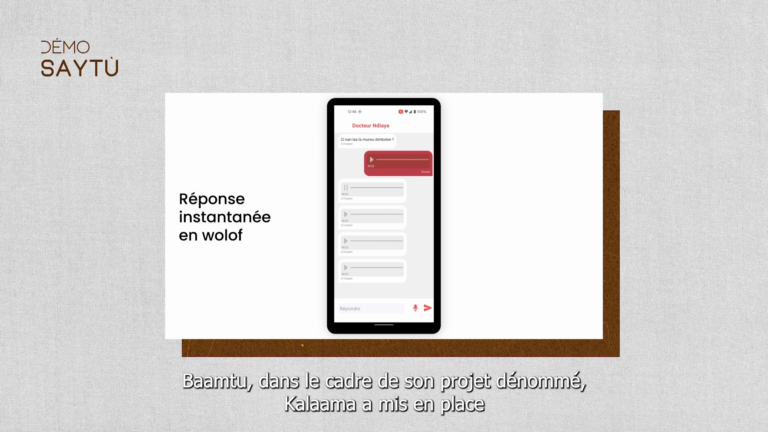
In Senegal, more than 300 people live with hemophilia, a rare disease. To enhance awareness and management of hemophilia, we have developed a voice chatbot in Wolof.
Indeed, hemophilia is a rare disease that prevents blood from clotting and can lead to potentially severe bleeding. This condition, still relatively unknown in the country, represents a major challenge in terms of awareness and patient care.
In this context, we have developed a Wolof voice chatbot for hemophilia in Senegal, an innovative digital solution aimed at improving awareness and management of this still little-known disease in the country.
This project was made possible through the collaboration of Awa Babington-Ashaye, PhD candidate and scientific consultant, Professor Antoine Geissbuhler, Director of the eHealth and Telemedicine Department at Geneva University Hospital (HUG), with financial support from the Novo Nordisk Haemophilia Foundation and in partnership with the Dakar Blood Transfusion Center (CNTS).
Table of content
ToggleI. Pourquoi un chatbot en Wolof contre l’hémophilie au Sénégal ?
Wolof is the most widely spoken language in Senegal, but few people are able to read it. Given this reality, and with over 80% of adults with hemophilia owning a smartphone, it became clear that technology needed to be leveraged to bridge this information gap.
The Wolof voice chatbot overcomes the language barrier by providing accessible and understandable answers to the Senegalese population. It uses voice, a more natural means of communication.
With Kàllaama, nous avons mis à disposition une synthèse vocale avancée et une reconnaissance du Wolof.
L’expérience utilisateur est fluide et naturelle, en permettant à l’utilisateur de poser des questions vocales et d’obtenir des réponses précises en Wolof.
Kàllaama is not just a text-to-audio conversion tool; it is a comprehensive system that includes both speech recognition and speech synthesis, specifically optimized for African local languages like Wolof. This natural language processing (NLP) model has ensured accurate understanding of vocal queries and provides clear, smooth, and natural responses, perfectly adapting to the culture and language of the Senegalese user.
II. Le rôle de Kàllaama dans la conception du chatbot Saytu hémophilie
Kàllaama is a suite of natural language processing solutions based on artificial intelligence. It enhances interaction by making communications more intuitive and accessible.
It has played a central role in the Saytu Hemophilia mobile application, designed to improve patient care.
– Kàllaama: A collection of innovative projects for our local languages
Kàllaama encompasses a series of projects that include three essential models: a speech recognition model (ASR), a speech synthesis model (TTS), and a machine translation model (NMT). Each of these models plays a key role in our efforts to promote the use of local languages, such as Wolof, in new technologies.
The speech recognition model transcribes voice into text. We live in a context where our national language, Wolof, is spoken more often than written.
Today, with platforms like WhatsApp, the use of voice has become a preferred means of communication, even for those with limited educational backgrounds.
Thus, a model that allows users to interact directly with technology through voice represents a significant advancement.
As for the speech synthesis model, it addresses an equally crucial need. A person who is not proficient in writing a language will also struggle to read it effectively. The speech synthesis system transforms written text into spoken discourse, thereby facilitating access to information for everyone.
Regarding machine translation, many resources are available on the web, but often in foreign languages. Our machine translation system aims to make these resources accessible by translating them into our local language. This also helps build corpora that can enrich other models, such as speech recognition or synthesis.
Ainsi, l’application Saytu hémophilie permet :
- Downloading educational videos on disease management,
- Geolocation of the nearest care centers,
- Access to emergency numbers for rapid assistance.
This application is fully manageable via a console, allowing the teams at HUG to easily update medical and contact information.
III. Impact of the wolof chatbot on Hemophilia awareness in Senegal
Ce projet ne s’arrête pas là. Avec l’expertise de BAAMTU en ingénierie logicielle et en intelligence artificielle, et la puissance de Kàllaama , de nouvelles langues locales, telles que le Dioula, le Pular ou le Bambara, peuvent être intégrées. D’autres maladies peuvent être prises en charge également . L’objectif est d’élargir l’impact du chatbot pour améliorer la qualité de vie des patients à travers une information accessible et pertinente.
The Saytu Hemophilia project is a significant advancement for raising awareness of the disease in Senegal.
By combining artificial intelligence, voice technologies, and the innovation of Kàllaama, we have developed a digital solution tailored to local needs. It now allows the Senegalese population to easily access essential information about hemophilia.
Aujourd’hui, dans divers domaines, nos chatbots sont conçus pour s’adapter à des besoins spécifiques tel que le service client avec des solutions telles que le STT (Speech-to-Text), le TTS (Text-to-Speech), et la traduction automatisée en langues locales.
La barrière linguistique n’est plus un défi avec la reconnaissance et l’interprétation en temps réel des requêtes vocales et textuelles provenant de diverses sources (WhatsApp, Twitter, etc.). Il n’est pas limité à la synthèse ou à la reconnaissance vocale de fichiers enregistrés . Il intègre une IA avancée capable de s’adapter aux besoins des utilisateurs, quel que soit le canal de communication ou la langue utilisée.
Don’t miss our upcoming write-up on the subject: Click here!
Souhaitez-vous être accompagné dans l’intégration d’un chatbot pour atteindre vos objectifs business ? Contact us by clicking here!